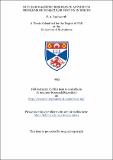Files in this item
Nuclear magnetic resonance applied to problems of molecular motion in solids
Item metadata
| dc.contributor.advisor | Allen, J. F. | |
| dc.contributor.author | Rushworth, F. A. | |
| dc.coverage.spatial | 110 p. | en_US |
| dc.date.accessioned | 2018-06-28T09:50:50Z | |
| dc.date.available | 2018-06-28T09:50:50Z | |
| dc.date.issued | 1953 | |
| dc.identifier.uri | https://hdl.handle.net/10023/14694 | |
| dc.description.abstract | The discovery of nuclear magnetic resonance in bulk matter in 1945 has led to advances in several branches of physics. One of the most interesting applications of these new techniques has been to problems of the solid state, where information about molecular motion and thermal relaxation effects can be obtained. It is with this field of research that the nuclear magnetic resonance absorption experiments reported in this thesis are concerned. The general theory of nuclear magnetic absorption is developed first and the relevant apparatus and experiment methods are then described. The design and performance of a large permanent magnet made especially for nuclear resonance work is considered and experiments on suitable solids are reported and discussed in the final section. | en_US |
| dc.language.iso | en | en_US |
| dc.publisher | University of St Andrews | |
| dc.subject.lcc | QC762.R8 | |
| dc.subject.lcsh | Nuclear magnetic resonance | en |
| dc.title | Nuclear magnetic resonance applied to problems of molecular motion in solids | en_US |
| dc.type | Thesis | en_US |
| dc.type.qualificationlevel | Doctoral | en_US |
| dc.type.qualificationname | PhD Doctor of Philosophy | en_US |
| dc.publisher.institution | The University of St Andrews | en_US |
This item appears in the following Collection(s)
Items in the St Andrews Research Repository are protected by copyright, with all rights reserved, unless otherwise indicated.

